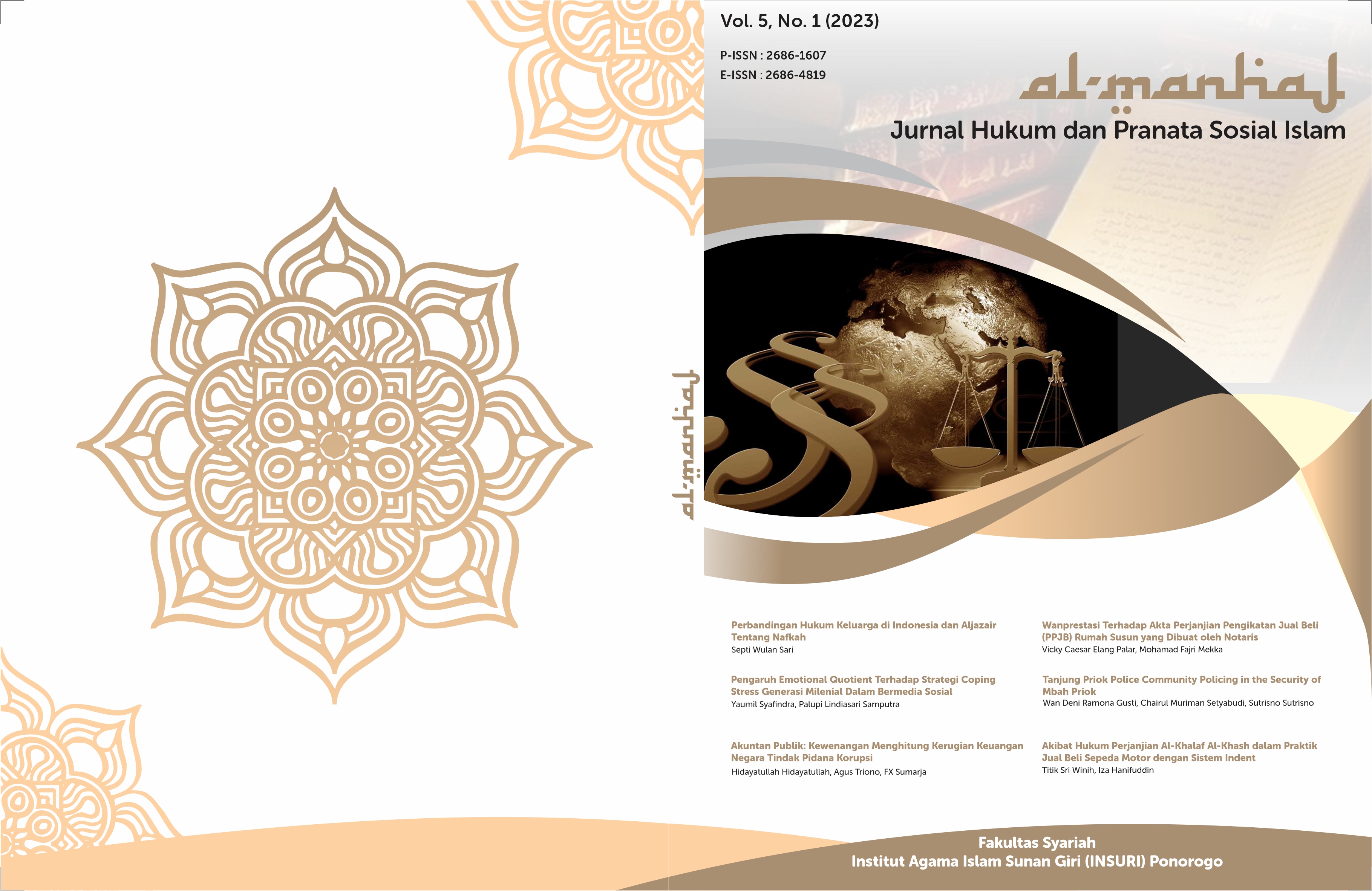Wakaf According to The Quran and its Transformations in Indonesia's Contemporary Era
DOI:
https://doi.org/10.37680/almanhaj.v5i1.2739Keywords:
Wakaf, Contemporary Era, TransformationAbstract
Objective: This article aims to reveal the meaning of waqf according to the Koran and its transformation in the contemporary era in Indonesia. Method: This research method uses Library Research whose primary focus is on library books and other literature. Based on the research objectives, it includes basic research, i.e. research to broaden and deepen theoretical knowledge. Result: This digital transformation is described as the total and overall effect of digitalization on society. Khan said that digitization has enabled the digitization process, which drives stronger opportunities to transform and change existing business capital, socio-economic structures, legal and policy measures, organizational patterns, cultural barriers, etc.
References
Ali, M. D. (1998). Sistem Ekonomi Islam. Jakarta: UI Press.
Abi Abdillah al-Qurthubi, Aljami’ li Ahkamil Qur’an Dar-al-Kutub al-Ilmiah Bairut, Lebanon 1996.
Amelia Fauzia, et.al., Fenomna Wakaf diIndonesia, Tantangan Menuju Wakaf Produktif.(Jakarta: Badna Wakaf Indonesia, 2019)
Andri Sumitro, Bank dan Lembaga Keuangan Syariah. Cetakan 5. (Jakarta: Prenadamedia Group, 2015)
Bakr, T. A. (n.d.). Kifayah al Akhyar. Mesir: Dar al Kitab al Araby.
Bambang Waluyo, 2010, Penelitian Hukum dalam Praktek, Sinar Grafika, Jakarta.
Departemen Agama RI, Fiqih Wakaf, (Jakarta: Direktorat Pemberdayaan Wakaf, 2007)
Hasan Mansur Nasution, dkk, 2007 Wakaf dan Pemberdayaan Umat, ed: Bandrun Nur Tanjung dan Farid Wajdi, Sinar Grafika, Jakarta.
Kabisi, M. A. (2004). Hukum WakaF.
Ibn Hajar al-Haytami, 2006, Syihab al-Din Ahmad, Tuhfah at-Muhtaj bi Syarh al-Minhaj jilid 6, , Dar Fikr, Beirut.
Johnny Ibrahim, 2012, Teori & Metode Penelitian Hukum Normatif, Bayumedia, Malang.
Manerep Albert Pasaribu, Strategi dan Transformasi Digital. (Jakarta: PT.Gramedia, 2020)
Muhammad Jawad Mughniyah, 2005, Fiqih Lima Mazha, Ja’fari, Hanafi, Maliki dan Syafi’I, Hambali, Terjemah Masykur AB dkk, Lantera, Jakarta.
Muhammad Abid Abdullah Al-Kabisi, 2004, Hukum Wakaf: Kajian Komteporer Pertama dan Terlengkap tentang Fungsi dan Pengolahaan Wakaf serta Penyelesaian Atas Sengketa, ed: Khaeron Sirin, Terjemah Ahrul Sani Faturrahman dan rekan-rekan KMCP, Cinere, IIMaN Press, Depok.
Mohammad Daud Ali, 1988, Sistem Ekonomi Islam, Zakat dan Wakaf, UI-Press, Jakarta, 1988.
Mughniyah, M. J. (2005). al Ahwal al Syakhisiyah. Jakarta: Ciputat Press.
Mughniyah, M. J. (2007). Fiqih Lima Mazhab. Jakarta: Penerbit Lentera.
Nabilatul Amaliyah, et.al., Wakaf Uang Digital: Transformasi dan Implementasi di Indonesia, Jurnal Ekonomi Islam AL-INFAQ, Vol. 13 No.1 Tahun 2022
Peraturan Perundang-undangan perwakafan, 2006 Departemen Agama Direktorat Jendral Bimbingan Masyarakat Islam.
Rachmadi Usman, 2013, Hukum Perwakafan di Indonesia, cet-II, Sinar Grafika, Jakarta.
Rahmawati, et.al., Transformasi Digital Wakaf BWI Dalam Menghimpun Wakaf di Era Digitalisasi, Jurnal Tabarru’ : Islamic Banking and Finance, Vol.4No. 2, November2021
Rofiq, A. (2007). Hukum Islam di Indonesia. Jakarta: PT. Raja Grafindo. Sabiq, S. (n.d.). Fiqih Sunnah, JUz 3. Beirut: Daarul Kutub.
Sri Adiningsih, Transformasi Ekonomi Berbasis Digital di Indonesia, (Jakarta: PT.Gramedia Pustaka Utama, 2019)
Sayyid Sabiq, 2008, Fiqh Sunnah, Terjemahan Asep sobari dkk, Al-I’tishom, Jakarta.
Sulistya, Hasanah, & Irfany, Strategi Pengelolaan Wakaf Uang oleh Badan Wakaf Indonesia (BWI). Jurnal Wakaf Dan Ekonomi Islam AL-AWQAF, Vol. 13 No.1 Tahun 2020.
Wahbah Az-Zuhaili, 2011, Fikih Islam Wa Adillatuhu, Terjemahan Abdul Hayyie al-Kattani dkk, cet-1, jilid 10, Gema Insani, Jakarta.
Zuhaili, W. (2008). al-fiqhu al-Islami wa 'Adillatuhu. Damaskus: Dar al Fikr
Downloads
Published
How to Cite
Issue
Section
License
Copyright:
- Author retains the copyright and grants the journal the right of first publication of the work simultaneously licensed under a Creative Commons Attribution 4.0 International License that allows others to share the work with an acknowledgment of the work's authorship and initial publication in this journal.
- Author is able to enter into separate, additional contractual arrangements for the non-exclusive distribution of the journal's published version of the work (e.g., post it to an institutional repository or publish it in a book) with the acknowledgment of its initial publication in this journal.
- Author is permitted and encouraged to post his/her work online (e.g., in institutional repositories or on their website) prior to and during the submission process, as it can lead to productive exchanges, as well as earlier and greater citation of the published work (See The Effect of Open Access).
License:
-
Attribution — You must give appropriate credit, provide a link to the license, and indicate if changes were made. You may do so in any reasonable manner, but not in any way that suggests the licensor endorses you or your use.
-
No additional restrictions — You may not apply legal terms or technological measures that legally restrict others from doing anything the license permits.
You are free to:
- Share — copy and redistribute the material in any medium or format
- Adapt — remix, transform, and build upon the material for any purpose, even commercially.

This work is licensed under a Creative Commons Attribution 4.0 International License.














